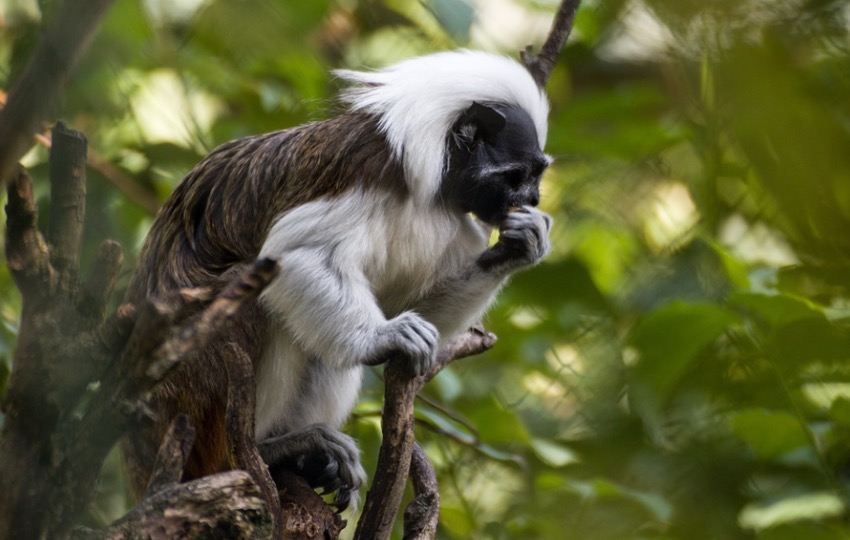Table of Contents
Tamarin: All You Need To Know
A Tamarin is an omnivorous primate which belongs to the kingdom of Animalia, phylum Chordata, and class Mammalia. Its genus is Saguinus and its species are Saguinus Ursula and 12 others. Its length is about 13 to 30 cm and it weighs about 220 to 900 g. It lives in the forest canopy, with a lifespan of up to 10 to 18 years.

Tamarin Description
The tamarin is a tiny New World monkey belonging to the genus Saguinus. The genus has 13 species, all of which dwell in the treetops of the Amazon basin and other areas of Central and South America. Most species, like their jungle environment, are endangered.

The golden lion tamarin (S. ursula) is one of the most well-known tamarin species. It has a magnificent golden-brown mane, similar to that of male lions. Its tiny, black face and rather lengthy tail are framed by this.
Some species have fascinating mustache-like characteristics, while others are black. The weight and length of the 13 species now identified in the genus range from 7.8-31.7 oz (220-900 g) and 5.1-11.8 in (13-30 cm), not including their tails.

Tamarin Diet and Predators
Tamarins are arboreal, meaning they live in trees throughout their tropical rainforest area. They’ll sleep in tree hollows here at night. They forage for food by leaping and climbing from branch to branch during the day. They’ll catch insects, fruit, even tiny lizards and birds using their lengthy fingers.
Tamarins are tiny primates who are preyed upon by a variety of predators. Snakes will eat them and their offspring. When possible, wild cats and several kinds of birds of prey will eat tamarins. To evade predation, they generally rely on their speed and ability to move quickly across the forest canopy. To avoid being discovered by predators, they would often hide in tree hollows at night.

Tamarin Breeding and Social Structure
Tamarins are sociable creatures who live in family groups of up to 40 people. A normal family group, on the other hand, may number about ten people. Males take an active role in rearing their babies, sometimes carrying them around between feedings.
Females usually have a gestation period of around 140 days after copulation. Females frequently have two babies at a time, usually twins. Males and other juveniles in the family will help raise the young monkeys, caring for them throughout the day but returning them to their mothers to breastfeed when necessary. New tamarins will start eating solid food around the age of one month.
They are not completely weaned from their mothers until they are around 3-4 months old. They will attain full maturity and become a self-sufficient member of the family by their second year. In captivity, tamarinds can live up to 18 years, but most species survive for just approximately 10 years.

Tamarin Status of Conservation
Tamarins are found mostly in the Amazon rainforest basin, which is one of the world’s most biodiverse regions. It is also one of the world’s most endangered places. Hundreds of thousands of additional species are losing their native habitats as a result of deforestation caused by logging and agriculture. The IUCN Red List now lists the golden lion tamarin as Endangered, which is an improvement over its former Critically Endangered classification.
Fun Facts About Tamarin!
Tamarins are found in a very small yet significant region of the planet. The tamarin is a wonderful monkey to learn more about since it has so many closely related species in such a limited and productive region.
Difficult to Categorize
The taxonomic classification of tamarinds is not straightforward. Originally, the genus Saguinus consisted of 10 species, each of which was further subdivided into morphotypes based on their distinct facial hair patterns. Later, dental measures were used to divide them into two clades, and then 15 species within the genus, with no subspecies.
In 2016, scientists studied the genus and other primates genetically. This showed that certain contemporary members of the genus, such as the saddle-back tamarin (Leontocebus spp.), split from other species about 10 million years ago, which is far earlier than other monkeys and marmosets from genera like Callithrix, Cebuella, and Mico. As a result, the saddle-back tamarin was transferred from Saguinus to Leontocebus, leaving Saguinus with 13 species.
The Golden Touch
The red-handed tamarin (Saguinus midas) has developed an attractive colour morph. This species is notable for the prominent golden hair on its hands, which contrasts with its mainly black fur. It is native to the forested areas north of the Amazon River. On its anterior side and rump, it also contains some gold flecking.
Fierce Competition
Some tamarin species are moving as their natural ranges are endangered by global climate change, which is altering weather patterns in various places. As competition for remaining habitat grows severe, this has repercussions for the environment and may potentially contribute to the extinction of other tamarin species.
Interspecific rivalry between the red-handed marmoset and the pied tamarin (Saguinus bicolor), which is spreading into the former’s historical territory, is causing the latter to be displaced by the former. This emphasises the difficulties connected with conservation efforts, which may at times attempt to preserve a vulnerable species by introducing it to a new range, causing harm to other species in the area.
Tamarin Citations
- Gross anatomy of the shoulder and arm intrinsic muscles in the white-footed tamarin (Saguinus leucopus – Günther, 1876): Inter- and intraspecific anatomical variations. J Med Primatol . 2020 Jun;49(3):123-135.
- Habitat determinants of golden-headed lion tamarin (Leontopithecus chrysomelas) occupancy of cacao agroforests: Gloomy conservation prospects for management intensification. Am J Primatol . 2020 Sep;82(9):e23179.
- Predation of treefrogs (Anura: Hylidae) with toxic skin secretions by the black lion tamarin (Leontopithecus chrysopygus, Callitrichinae). Primates . 2020 Jul;61(4):567-572.







